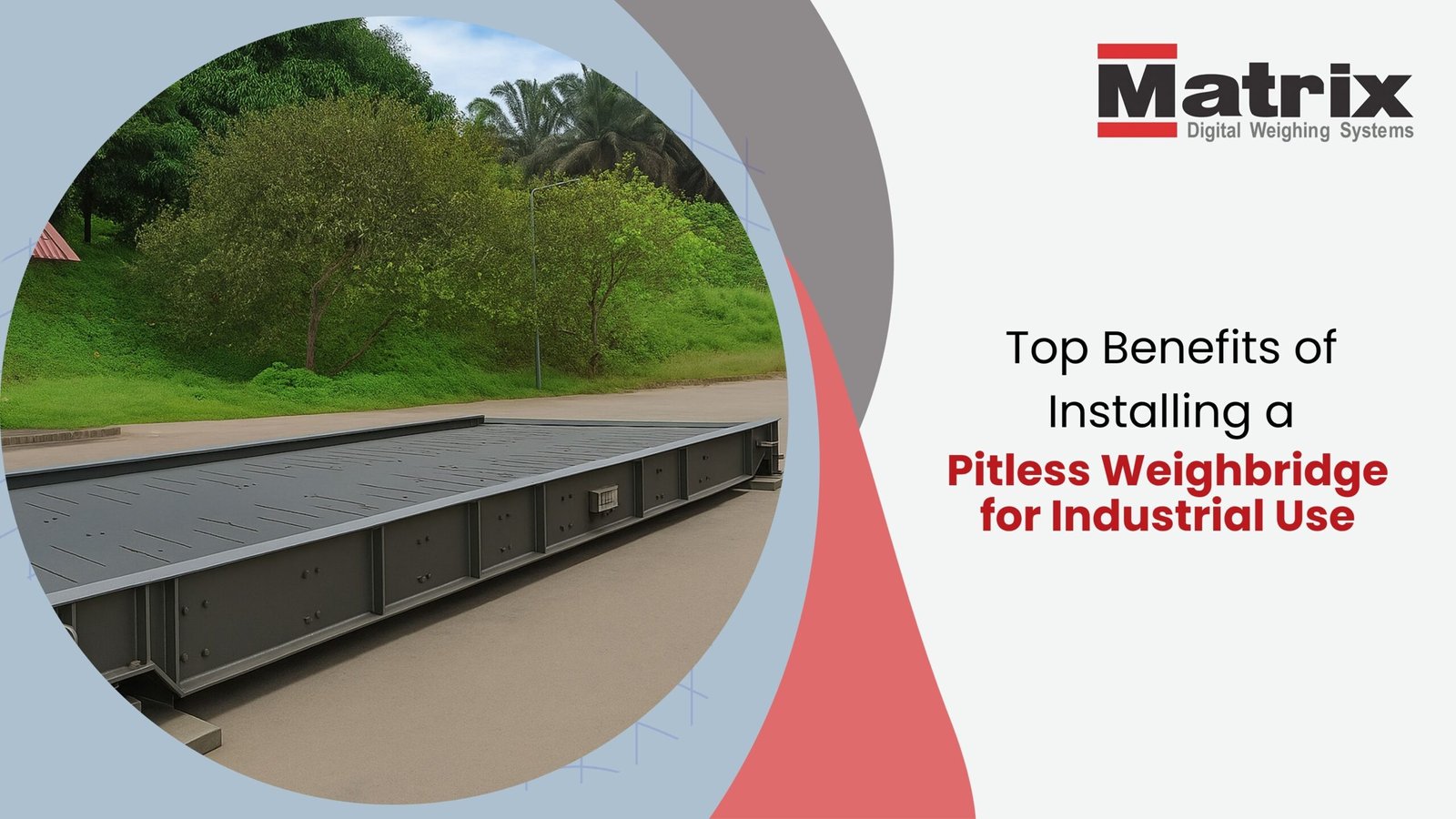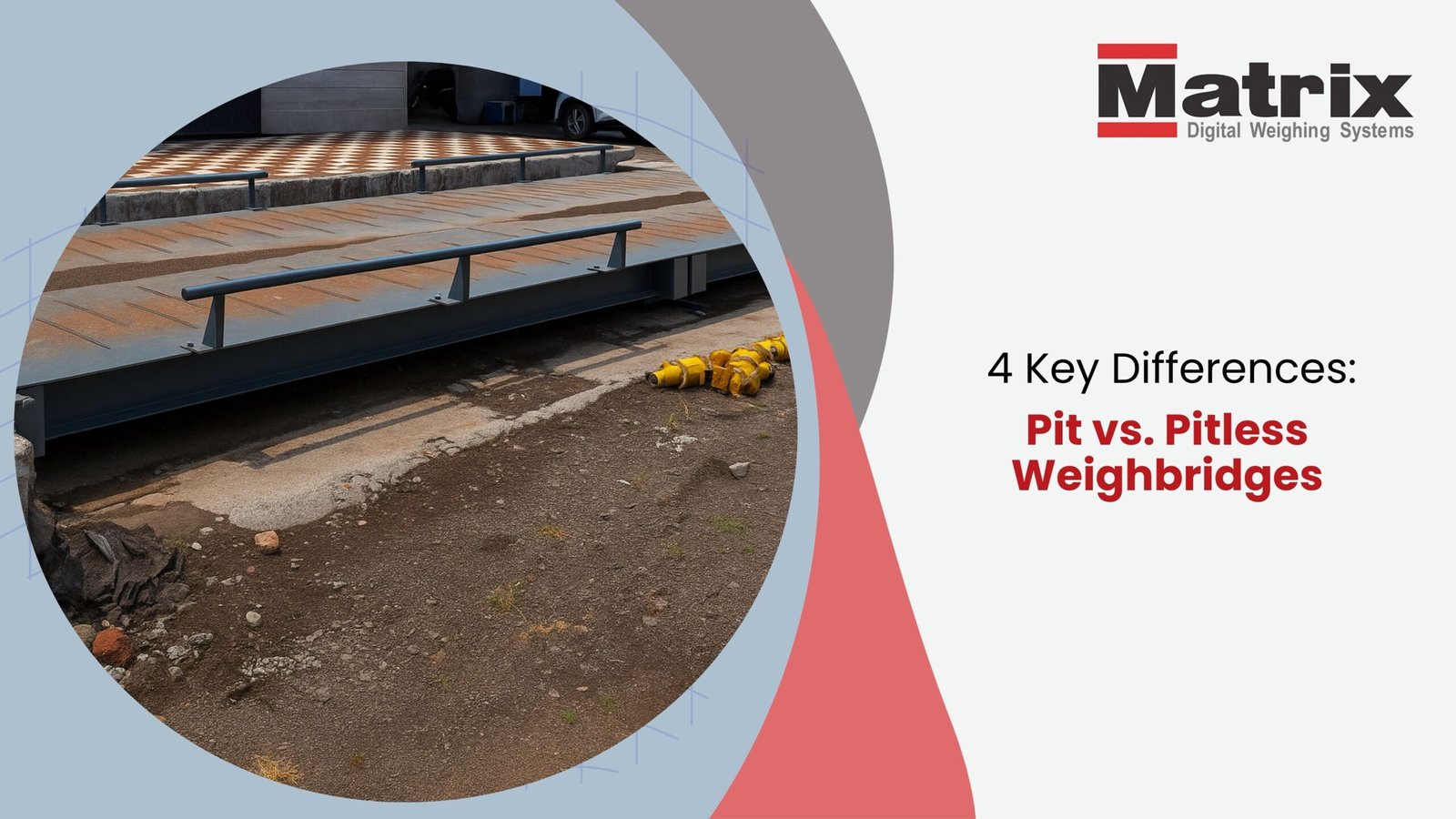Top Benefits of Installing a Pitless Weighbridge for Industrial Use

Weighbridge selection impacts site, civil engineering, uptime, and cash flow. Pits invite delays, water troubles, and service headaches. Many Indian sites face high water tables, heavy monsoon rain, and tight project schedules. That mix punishes pit-type layouts. A pitless system solves these realities with simpler civil work, faster commissioning, and easier upkeep.
This guide lays out what a pitless weighbridge is, why it reduces lifetime effort, and when it’s the smarter fit. You’ll see the trade-offs, the site requirements, and a plain-english checklist to move from decision to install without surprises. We build and support weighbridges across industries and terrains, so the advice here is grounded in field use.
What is a pitless weighbridge
A pitless weighbridge sits on a surface foundation with approach ramps instead of a sunken pit.
- The deck is above ground.
- Load cells, junction boxes, and cabling remain accessible.
- Vehicles drive up and down via ramps that extend the overall length.
The result: less digging, fewer water risks, and faster access for service.
Key benefits
Faster installation
Pitless foundations involve shallower excavation and simpler shuttering. That means fewer permits, shorter civil timelines, and quicker handover. For plants on deadline—cement grinding units, steel yards, agro-commodity hubs—those saved days matter.
Easier maintenance
All critical parts sit above ground. Technicians can inspect load cells, cables, and mounts without confined-space procedures. Replacement jobs take hours, not days. That reduces stoppages and keeps your weigh lane moving.
Better monsoon resilience
No pit means no standing water. Waterlogging corrodes hardware, warps wiring, and throws off readings. During peak monsoon, an above-ground deck stays usable with routine housekeeping—washdowns, debris removal, and clear approaches.
Lower civil costs on most sites
You avoid pit excavation, deeper PCC/RCC, retaining walls, and elaborate drainage. The cost edge grows on hard ground, rock layers, or areas with high ground water. Where earthwork is slow or expensive, pitless pays back early.
Easier relocation and expansion
If your operation shifts—temporary depots, project sites, mining faces—you can relocate a pitless deck faster. Modular platforms and surface frames make moves feasible in a planned shutdown.
Safer, cleaner operations
No open pit reduces fall risk and confined-space entries. Housekeeping is straightforward: sweep, wash, and keep ramps clear. That keeps operators comfortable and SOPs simple.
Accuracy you can trust
With a sound foundation, quality load cells, proper earthing, and routine calibration, pitless systems deliver trade-class accuracy day after day. Good mounting and anti-lift provisions keep readings stable even with heavy truck traffic.
When pitless is the better choice
- High water table or heavy rain: Coastal belts, river basins, and monsoon-intense regions benefit from an above-ground deck.
- Hard or rocky strata: Deep pits mean slow, costly excavation; pitless avoids that grind.
- Tight commissioning windows: Brownfield plants, fast-ramping warehouses, and seasonal procurement yards need speed.
- Temporary or semi-permanent use: Projects that move—EPC sites, stone crushers, construction camps—gain flexibility.
Site requirements
- Space for ramps: Plan for approach ramps (often ~3–3.5 m each side, based on gradient and vehicle mix).
- Vehicle flow: Keep a clean straight approach; avoid sharp turns, slopes, and soft shoulders.
- Drainage and housekeeping: Provide cross-fall, soak pits, or channels to move water off the deck and approaches.
- Power and earthing: Stable supply, dedicated earthing, and surge/lightning protection protect electronics.
- Safety furniture: Wheel guides, bollards, and clear line marking improve alignment and speed up throughput.
Pitless vs pit-type
- Civil work: Pitless = shallow foundation + ramps; Pit-type = deep excavation + drainage + pit walls.
- Footprint: Pitless uses more horizontal length; Pit-type is compact on length but deeper below grade.
- Water risk: Pitless avoids waterlogging; Pit-type needs strong drainage and regular pit cleaning.
- Maintenance access: Pitless is open access; Pit-type often requires confined-space protocols.
- Relocation: Pitless can be moved; Pit-type is largely permanent.
- Aesthetics and height: Pit-type sits flush with ground; Pitless stands proud; wheel guides help alignment.
Implementation checklist
- Traffic study: Count peak-hour movements, truck types, turning radius, and queue length.
- Foundation design: Follow manufacturer drawing; verify soil bearing capacity; use M-grade concrete as specified.
- Ramp gradient: Balance traction and space; check heavy-axle vehicles can start/stop safely on grade.
- Drainage plan: Cross-falls, channels, and sumps to keep the deck and ramps dry.
- Earthing and lightning: Dedicated earth pits, copper strip/rod as per spec, SPD at control room.
- Instrumentation layout: Conduit routing, junction box placement, protected cable paths.
- Calibration plan: Initial stamping, routine checks, and a quick-response service protocol.
- Integration: Connect terminal, printer, boom barrier, ANPR, and ERP/WMS as needed with tested workflows.
- SOPs and training: Short, visual SOPs for operators—alignment, zero checks, print discipline, and housekeeping.
FAQs
Q: Do pitless weighbridges need more space?
A: Yes. Ramps add length. In most yards, the trade-off is acceptable because civil work is simpler and uptime is higher. Plan entry/exit lanes to avoid congestion.
Q: Will rain affect accuracy?
A: Not if the foundation is solid and the deck stays clean. Most issues arise from debris, mud on ramps, or poor drainage. A short daily housekeeping routine prevents drift.
Q: Can pitless handle very heavy traffic?
A: Yes, provided the platform, load cells, and anchors match the duty class and axle loads. Routine tightening checks and scheduled calibration keep readings true.
Q: What about dust-heavy sites like quarries?
A: Use wheel-wash or a basic spray line at the approach, fit wheel guides, and keep a broom and blower on the operator’s checklist. The open design makes cleaning quick.
Q: Is relocation actually practical?
A: For project-style setups or seasonal yards, yes. Plan for crane access, safe lifting points, and cable re-termination. Foundation pads at the new site keep downtime low.
Conclusion
A pitless weighbridge fits India’s on-ground realities—monsoons, shifting projects, hard strata, and tight commissioning windows. It cuts civil work, speeds installation, and simplifies service. If your goal is reliable throughput with fewer stoppages, pitless is a strong first choice.
Matrix Weighbridge
We help industrial teams install pitless weighbridges that start fast, weigh right, and stay online. Our approach is practical: clean foundations, clean cabling, clean data. Talk to us for a site-specific plan, clear timelines, and a firm quote. Book a site assessment today.

